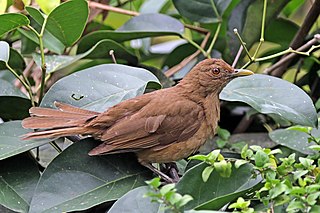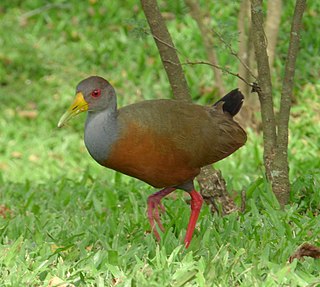
The common blackbird is a species of true thrush. It is also called the Eurasian blackbird, or simply the blackbird where this does not lead to confusion with a similar-looking local species. It breeds in Europe, Asiatic Russia, and North Africa, and has been introduced to Australia and New Zealand. It has a number of subspecies across its large range; a few of the Asian subspecies are sometimes considered to be full species. Depending on latitude, the common blackbird may be resident, partially migratory, or fully migratory.

The ring ouzel is a mainly European member of the thrush family Turdidae. It is a medium-sized thrush, 23–24 centimetres (9.1–9.4 in) in length and weighing 90–138 grams (3.2–4.9 oz). The male is predominantly black with a conspicuous white crescent across its breast. Females are browner and duller than males, and young birds may lack the pale chest markings altogether. In all but the northernmost part of its range, this is a high-altitude species, with three races breeding in mountains from Ireland east to Iran. It breeds in open mountain areas with some trees or shrubs, the latter often including heather, conifers, beech, hairy alpenrose or juniper. It is a migratory bird, leaving the breeding areas to winter in southern Europe, North Africa and Turkey, typically in mountains with juniper bushes. The typical clutch is 3–6 brown-flecked pale blue or greenish-blue eggs. They are incubated almost entirely by the female, with hatching normally occurring after 13 days. The altricial, downy chicks fledge in another 14 days and are dependent on their parents for about 12 days after fledging.

Plasmodium is a genus of unicellular eukaryotes that are obligate parasites of vertebrates and insects. The life cycles of Plasmodium species involve development in a blood-feeding insect host which then injects parasites into a vertebrate host during a blood meal. Parasites grow within a vertebrate body tissue before entering the bloodstream to infect red blood cells. The ensuing destruction of host red blood cells can result in malaria. During this infection, some parasites are picked up by a blood-feeding insect, continuing the life cycle.

The Plasmodiidae are a family of apicomplexan parasites, including the type genus Plasmodium, which is responsible for malaria. This family was erected in 1903 by Mesnil and is one of the four families in the order Haemospororida.

The clay-colored thrush is a common Middle American bird of the thrush family (Turdidae). It is the national bird of Costa Rica, where it is well known as the yigüirro. Other common names include clay-colored robin.
Haemamoeba is a subgenus of the genus Plasmodium — all of which are parasites. The subgenus was created in 1963 by created by Corradetti et al.. Species in this subgenus infect birds.
Plasmodium coggeshalli is a parasite of the genus Plasmodium subgenus Haemamoeba.
Plasmodium tumbayaensis is a parasite of the genus Plasmodium.
Plasmodium durae is a parasite of the genus Plasmodium subgenus Giovannolaia.
Plasmodium polare is a parasite of the genus Plasmodium subgenus Papernaia.

The grey-cowled wood rail or grey-necked wood rail is a species of bird in the family Rallidae, the rails. It lives primarily in the forests, mangroves, and swamps of Central and South America. Of the two subspecies, A. c. avicenniae is found in southeastern Brazil, while the nominate is found throughout the portion of the range not occupied by the other subspecies. The species as a whole is usually found at elevations from sea level to 2,000 metres (6,600 ft), although some have been found above that. This bird's large extent of occurrence along with its population is why it is considered to be least-concern by the International Union for Conservation of Nature (IUCN). In some places, it is occasionally hunted and kept for food.

The slaty-backed nightingale-thrush is a species of bird in the family Turdidae. It is found in Bolivia, Colombia, Costa Rica, Ecuador, Panama, Peru, and Venezuela.
Plasmodium forresteri is a parasite of the genus Plasmodium.
Plasmodium circumflexum is a parasite of the genus Plasmodium subgenus Giovannolaia.
Plasmodium vaughani is a parasite of the genus Plasmodium, and the type species of the subgenus Novyella. As in all Plasmodium species, P. vaughani has both vertebrate and insect hosts. The vertebrate hosts for this parasite are birds.
Plasmodium tejerai is a parasite of the genus Plasmodium subgenus Haemamoeba.
Plasmodium unalis is a parasite of the genus Plasmodium subgenus Novyella. As in all Plasmodium species, P. unalis has both vertebrate and insect hosts. The vertebrate hosts for this parasite are birds.
Plasmodium matutinum is a parasite of the genus Plasmodium subgenus Haemamoeba.






